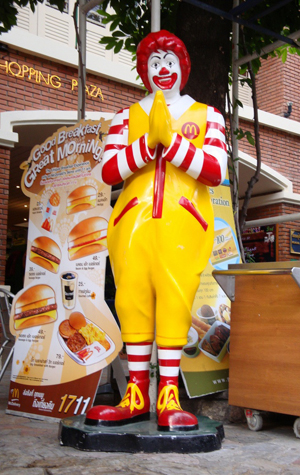Clown Time Is Over
MED pediatrician wants to retire Ronald McDonald

The media have dubbed it the down-with-the-clown campaign: more than 1,000 health care professionals, including almost two dozen professors and staffers at the School of Medicine and Boston Medical Center, signed a petition earlier this month asking McDonald’s to halt all advertising to children, “from Ronald McDonald to toy giveaways.”
Among the signers of the petition, which appeared in ads in major newspapers, was Alan Meyers, a MED associate professor of pediatrics and a staff physician with BMC’s Nutrition and Fitness for Life Program. Meyers sits on the advisory board for the anti-Ronald campaign, funded by the Boston-based nonprofit Corporate Accountability International.
McDonald’s CEO Jim Skinner responded to the ad by vowing that the iconic red-haired clown “isn’t going anywhere.” McDonald’s shareholders, meanwhile, stiff-armed a proposal for a report on company responses to the obesity problem.
The signers attacked Ronald as part of a broader campaign against childhood obesity, which they say McDonald’s encourages by marketing unhealthful food to kids. They point to a 2010 Yale study suggesting that when children are presented with identical junk food, they prefer products with cartoon characters like Ronald plastered on the packaging.
Marketing junk food to kids “is toxic and really should be done away with,” says Meyers, who also blames other fast-food chains, as well as federal subsidies to producers of high-calorie junk food ingredients. Those subsidies tripled in the 1980s, the same time that obesity rates took off. McDonald’s was the pioneer in fast-food advertising, spending $665 million on ads in 2003, Meyers says, while Burger King’s ad budget was $385 million. That same year, the Centers for Disease Control had just $51 million to advertise its children’s health campaign.
Meyers discussed the issue with BU Today.
BU Today: What have you got against Ronald McDonald?
Meyers: I’ve been here since 1980. Over that time, I have seen—as every child health clinician has—this obesity epidemic tripling since a very specific point in time. This began sometime between 1980 and ’88. Rates were very stable before that. Something very big happened. We have seen changes in caloric intake, and that has followed changes in food production around 1983. That’s the point at which the food industry began producing an average of 500 calories extra per person, per day.
Why?
They produced more corn. The reason corn production went up was government policies and subsidies. They started to subsidize the crop and said, “However much you produce, we’ll purchase it.” Most corn is fed to livestock, and some of it is converted to high-fructose corn syrup. The meat is fattier—livestock are not evolved to consume corn, they’re evolved to consume grass. And more sugar in soda—high-fructose corn syrup was a boon to the junk food industry because it’s cheaper than table sugar.
Ray Kroc, the founder of McDonald’s, discovered that including a toy with food brought the kids in the door. Now you had a meal of a higher caloric density, and a toy in there. You’re supersizing it—that was the other discovery. A paper in 2004 said on a typical day, almost a third of children aged 4 to 19 reported consuming fast food.
What do you say to claims that getting rid of toys and advertising and Ronald McDonald will not solve the problem as long as parents indulge their kids at McDonald’s?
There’s some truth to that. There’s also truth to the fact that advertising works. They have the best social psychologists that money can buy to give kids the tools to manipulate parents. It’s not a fair fight. Kids see 40,000 ads a year on TV. They’re bombarded, as are the parents. If you have a kid nagging all day long, “Take me to McDonald’s”—or some parents will say, “I’ll take you to McDonald’s if you’re good”—if the kids weren’t targeted, they wouldn’t be asking for it.
Why not demand a change in agriculture policy?
Absolutely. Why does a salad cost more than a Big Mac? It’s a long-term process. Politics are politics. The big interests are powerful, and they’re huge businesses. This is such a serious situation that we have to utilize every means we have. This campaign to stop this kind of advertising, to me, is public education.
McDonald’s claims, according to Reuters, that it “allows parents to swap milk or juice for soda in its Happy Meals. It offers sliced apples with caramel sauce as alternatives to French fries and burgers. It has added healthier options to its menu.”
The question is, does that affect behavior of the children who get pulled in to McDonald’s. I’ll show you the answer: a 2006 story from the New York Times.
The story that noted McDonald’s sales were up, not due to healthful food, but to “their dollar menu of traditional fast food”?
Right. That’s what the kids are eating.
Do you have kids?
I have two stepsons—they’re grown—and a granddaughter. We didn’t go for fast-food stuff. The marketing wasn’t as bad then. I don’t remember the same kind of pressure.
Rich Barlow can be reached at barlowr@bu.edu.
Comments & Discussion
Boston University moderates comments to facilitate an informed, substantive, civil conversation. Abusive, profane, self-promotional, misleading, incoherent or off-topic comments will be rejected. Moderators are staffed during regular business hours (EST) and can only accept comments written in English. Statistics or facts must include a citation or a link to the citation.